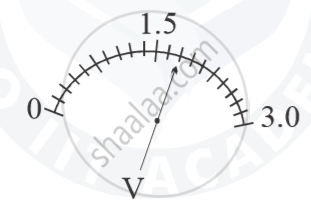Advertisements
Advertisements
Question
Suppose there is a circuit consisting of only resistances and batteries and we have to double (or increase it to n-times) all voltages and all resistances. Show that currents are unaltered. Do this for circuit of Example 3.7 in the NCERT Text Book for Class XII.
Solution
Let us first assume the equivalent internal resistance of the battery is Reff, the equivalent external resistance R and the equivalent voltage of the battery is Veff.
Now by applying Ohm's law,
Then current through R is given by `I = (V_"eff")/(R_"eff" + R)`

Now according to the question if all the resistances and the effective voltage are increased n-times, then we have
`V_("eff")^("new") = nV_("eff"), R_("eff")^("new") = nR_("eff")`
And Rnew = nR
Then, the new current is given by
`I^' = (nV_("eff"))/(nR_("eff") + nR) = (n(V_("eff")))/(n(R_("eff") + R)) = ((V_("eff")))/((R_("eff") + R)) = I`
The last result of two equations is same, so we can say that current remains the same.
APPEARS IN
RELATED QUESTIONS
A resistance of 40 ohms and one of 60 ohms are arranged in series across 220 volt supply. Find the heat in joules produced by this combination of resistances in half a minute.
Which of the following is an ohmic resistance?
In an experiment of verification of Ohm’s law following observations are obtained.
|
Potential difference V (in volt) |
0.5 | 1.0 | 1.5 | 2.0 | 2.5 |
| current I (in ampere) | 0.2 | 0.4 | 0.6 | 0.8 | 1.0 |
Draw a V-I graph and use this graph to find:
- the potential difference V when the current I is 0.5 A,
- the current I when the potential difference V is 0.75 V,
- the resistance in a circuit.
What length of copper wire of resistivity 1.7 × 10-8 Ω m and radius 1 mm is required so that its resistance is 2Ω?
Consider the sacle of voltmeter shown in the diagram and answer the following questions :

(a) What is the least count of the voltmeter?
(b) What is the reading shown by the voltmeter ?
(c) If the voltmeter is connected across a resistor of 20 `Omega` how much current is flowing through the resistor?
SI unit of resistance is:
Explain the equivalent resistance of a parallel resistor network.
The resistance of a nichrome wire at 0°C is 10Ω. If its temperature coefficient of resistivity of nichrome is 0.004/ °C, find its resistance of the wire at boiling point of water. Comment on the result.
Which of the following I-V graph represents ohmic conductors?
State Ohm’s law? How can it be verified experimentally? Does it hold good under all conditions? Comment.
